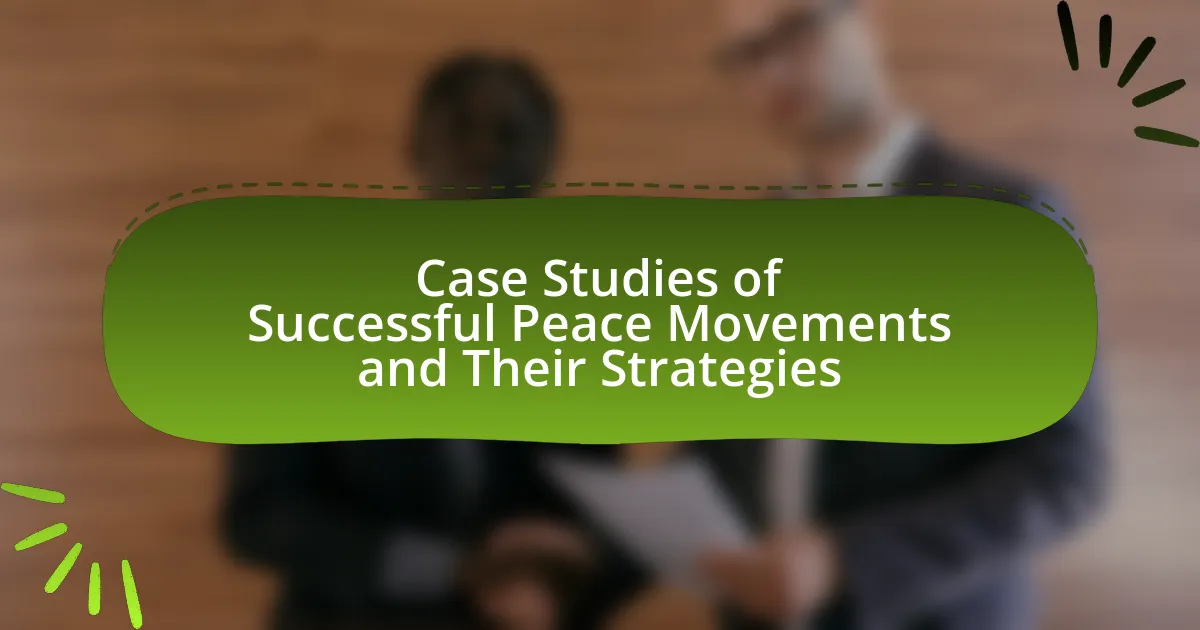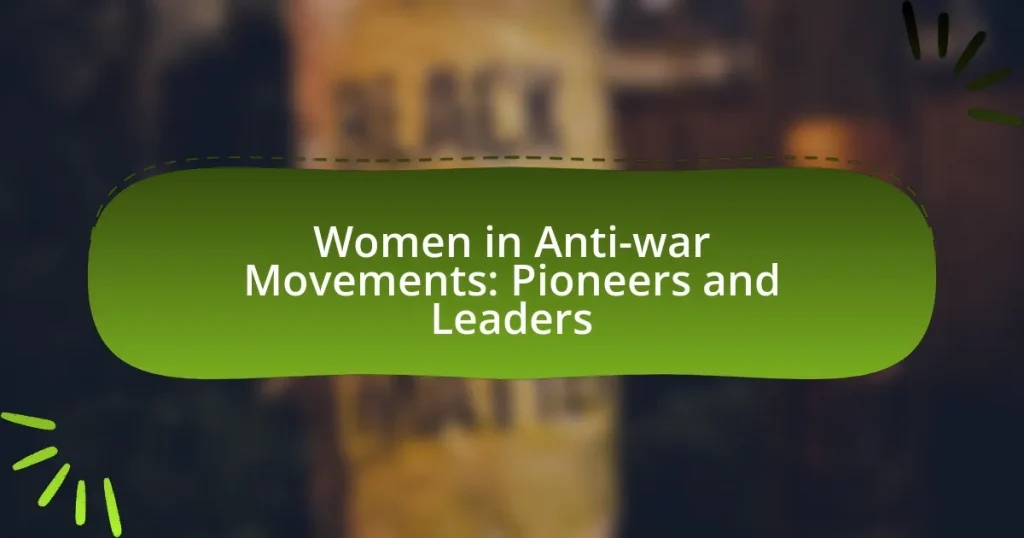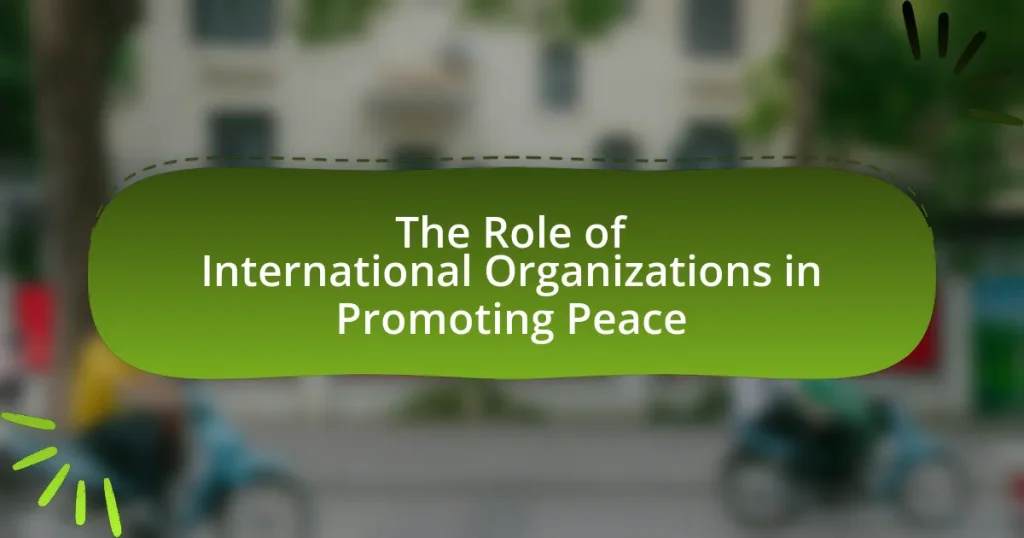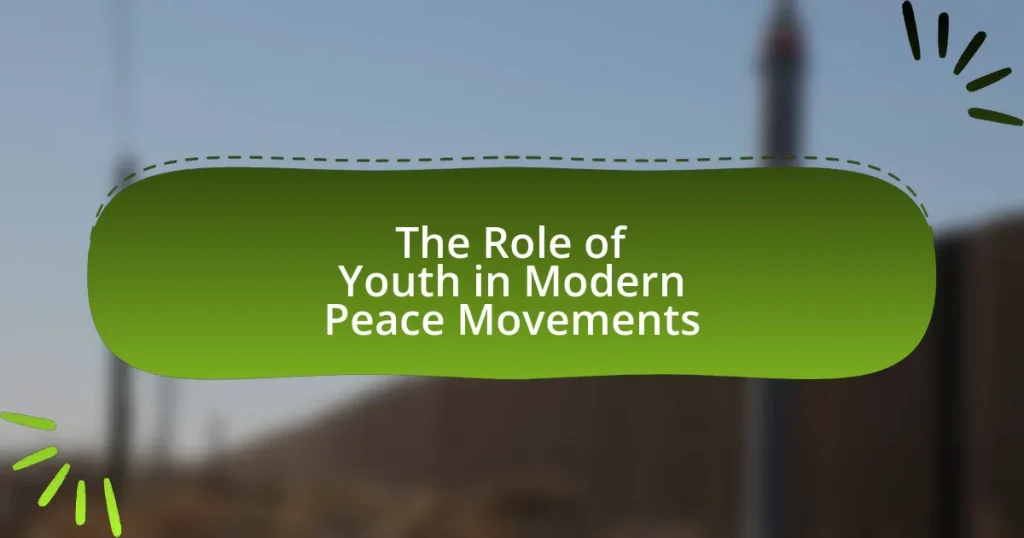The article examines case studies of successful peace movements, focusing on their strategies and defining characteristics. It highlights historical examples such as the Civil Rights Movement in the United States and the anti-apartheid movement in South Africa, illustrating how nonviolent resistance, grassroots mobilization, and coalition-building contributed to their achievements. The article also discusses the criteria for evaluating success in peace movements, the impact of cultural perceptions, and the role of public support and effective communication strategies. Additionally, it offers practical insights and best practices derived from these movements that can inform current peace initiatives.
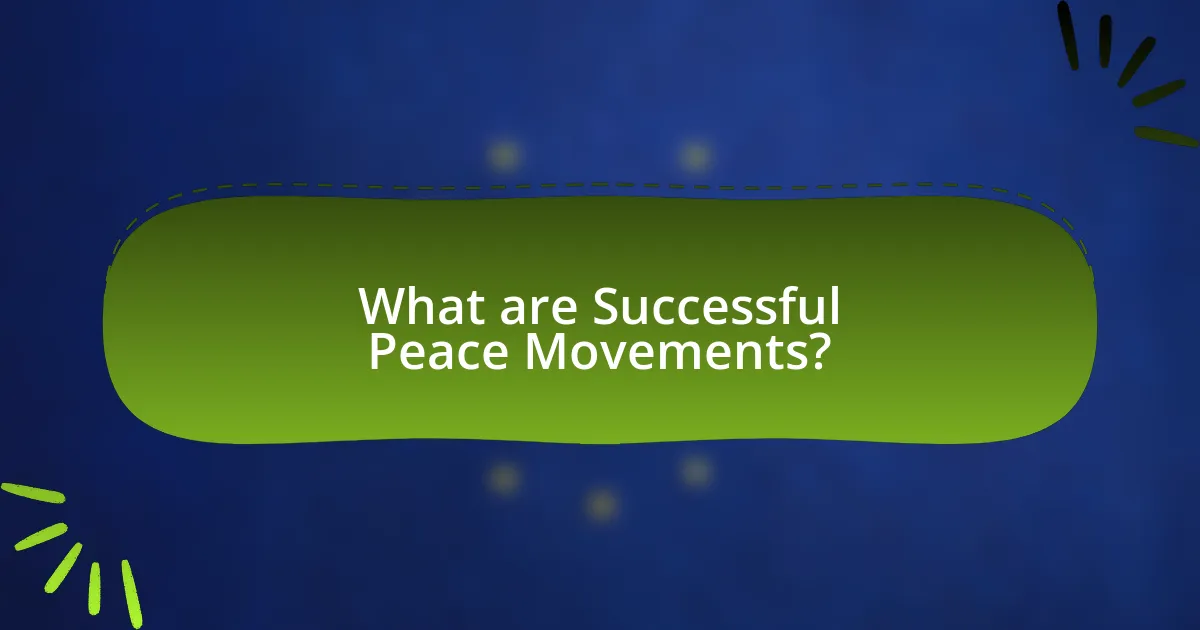
What are Successful Peace Movements?
Successful peace movements are organized efforts aimed at promoting non-violence and resolving conflicts through dialogue and negotiation rather than armed struggle. Historical examples include the Civil Rights Movement in the United States, which effectively utilized nonviolent resistance to combat racial segregation and discrimination, leading to significant legislative changes such as the Civil Rights Act of 1964. Another example is the anti-apartheid movement in South Africa, which mobilized international support and internal resistance, culminating in the end of apartheid and the establishment of a democratic government in 1994. These movements demonstrate that strategic planning, grassroots mobilization, and the ability to engage diverse stakeholders are critical components of successful peace initiatives.
How do we define success in peace movements?
Success in peace movements is defined by the achievement of tangible outcomes that lead to the cessation of violence and the establishment of lasting peace. This includes the resolution of conflicts through dialogue, the implementation of peace agreements, and the promotion of social justice and human rights. For instance, the peace process in South Africa, which culminated in the end of apartheid, exemplifies success as it involved negotiations that resulted in a democratic government and reconciliation efforts, significantly reducing violence and fostering social cohesion.
What criteria are used to evaluate the success of peace movements?
The success of peace movements is evaluated based on criteria such as the achievement of specific goals, the level of public engagement, and the sustainability of the changes initiated. Achieving specific goals includes the cessation of violence, the establishment of peace treaties, or the implementation of policy changes that promote social justice. The level of public engagement is assessed through participation rates, media coverage, and the movement’s ability to mobilize diverse groups. Sustainability refers to the lasting impact of the movement’s outcomes, which can be measured by ongoing peace initiatives, community resilience, and the prevention of future conflicts. These criteria are supported by historical examples, such as the Civil Rights Movement in the United States, which successfully led to legislative changes and increased public awareness about racial equality.
How do different cultures perceive success in peace initiatives?
Different cultures perceive success in peace initiatives through various lenses, often influenced by their historical, social, and political contexts. For instance, in Western cultures, success may be measured by the establishment of formal agreements and the cessation of hostilities, as seen in the Dayton Accords that ended the Bosnian War in 1995. In contrast, many Indigenous cultures prioritize community healing and restoration of relationships over formal agreements, emphasizing the importance of reconciliation and cultural preservation, as demonstrated in the Truth and Reconciliation Commission in Canada. Additionally, collectivist societies may view success in terms of societal harmony and collective well-being, while individualistic cultures might focus on personal freedoms and rights. These differing perspectives highlight that success in peace initiatives is not universally defined but rather shaped by cultural values and historical experiences.
What historical context is important for understanding peace movements?
Understanding peace movements requires examining the historical context of conflict, social change, and activism. Key events such as World War I and II, the Vietnam War, and the Civil Rights Movement significantly shaped the landscape of peace activism. For instance, the aftermath of World War I led to the establishment of organizations like the League of Nations, which aimed to promote peace and prevent future conflicts. The Vietnam War catalyzed widespread protests in the 1960s, highlighting the role of grassroots activism in advocating for peace. Additionally, the Civil Rights Movement demonstrated how social justice issues intersect with peace efforts, as leaders like Martin Luther King Jr. emphasized nonviolent resistance. These historical contexts illustrate how peace movements have evolved in response to specific conflicts and societal challenges, reinforcing the importance of understanding their origins and motivations.
What major global events have influenced peace movements?
Major global events that have influenced peace movements include World War I, World War II, the Vietnam War, and the Cold War. World War I catalyzed the formation of organizations like the League of Nations, aiming to prevent future conflicts. World War II led to the establishment of the United Nations, which promoted international cooperation and peacekeeping efforts. The Vietnam War sparked widespread anti-war protests, particularly in the United States, highlighting the public’s demand for peace and influencing future movements. The Cold War era saw the rise of nuclear disarmament campaigns, as the threat of nuclear war galvanized global peace activism. Each of these events significantly shaped the strategies and goals of peace movements worldwide.
How have social and political climates shaped peace movements over time?
Social and political climates have significantly shaped peace movements over time by influencing public sentiment, mobilization strategies, and the political context in which these movements operate. For instance, during the Vietnam War, widespread anti-war sentiment in the United States, fueled by media coverage and grassroots activism, led to a powerful peace movement that successfully pressured the government to withdraw troops. Similarly, the civil rights movement in the 1960s utilized the prevailing social climate of increasing awareness around racial injustice to advocate for peace and equality, demonstrating how social awareness can catalyze organized efforts for peace. Historical examples, such as the anti-nuclear movement in the 1980s, also illustrate how political tensions and public fear can galvanize collective action for disarmament, showcasing the direct correlation between the political environment and the effectiveness of peace movements.
What common characteristics do successful peace movements share?
Successful peace movements share characteristics such as strong leadership, clear goals, grassroots mobilization, and effective communication strategies. Strong leadership provides direction and inspires participants, while clear goals help unify efforts and maintain focus. Grassroots mobilization engages a broad base of support, ensuring diverse participation and resilience. Effective communication strategies, including the use of social media and traditional media, amplify messages and raise awareness, as seen in movements like the Civil Rights Movement in the United States, which utilized organized campaigns and media coverage to garner support and effect change.
How do leadership and organization impact the effectiveness of peace movements?
Leadership and organization significantly enhance the effectiveness of peace movements by providing direction, unity, and strategic planning. Effective leaders inspire and mobilize participants, fostering a shared vision that aligns individual efforts toward common goals. For instance, Martin Luther King Jr.’s leadership during the Civil Rights Movement galvanized diverse groups, resulting in impactful actions such as the Montgomery Bus Boycott, which led to significant legislative changes. Additionally, well-structured organizations facilitate resource allocation, communication, and coordination among members, which are crucial for sustaining momentum and achieving objectives. Research indicates that organized movements, such as the anti-apartheid struggle in South Africa, achieved greater success due to their strategic planning and cohesive leadership, ultimately leading to the dismantling of apartheid in the early 1990s.
What role does public support play in the success of peace movements?
Public support is crucial for the success of peace movements as it provides the necessary legitimacy, resources, and momentum for their initiatives. When a significant portion of the population endorses a peace movement, it can influence policymakers and create a favorable political environment. For instance, the Civil Rights Movement in the United States gained substantial traction due to widespread public support, which helped to enact legislative changes such as the Civil Rights Act of 1964. Additionally, research indicates that movements with higher public backing are more likely to achieve their goals, as seen in the anti-apartheid movement in South Africa, where global public support played a pivotal role in dismantling the apartheid regime.
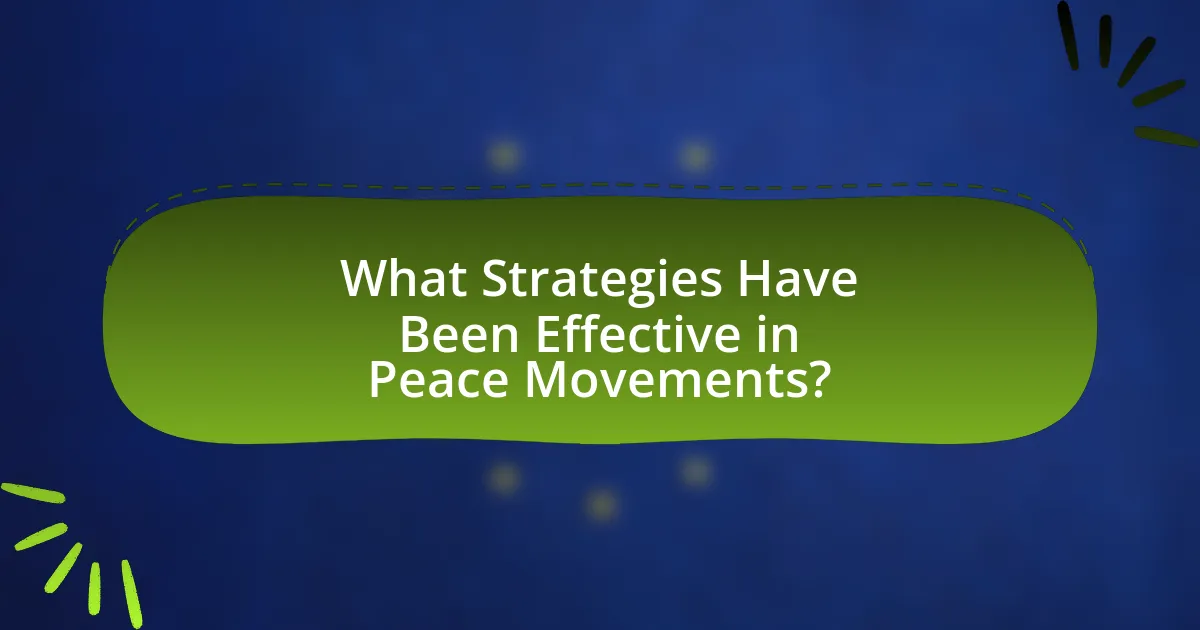
What Strategies Have Been Effective in Peace Movements?
Effective strategies in peace movements include nonviolent resistance, grassroots organizing, and coalition-building. Nonviolent resistance, exemplified by figures like Mahatma Gandhi during the Indian independence movement, has proven to mobilize large segments of the population while minimizing backlash. Grassroots organizing fosters community engagement and empowers individuals, as seen in the Civil Rights Movement in the United States, where local leaders galvanized support for systemic change. Coalition-building, demonstrated by the anti-apartheid movement in South Africa, unites diverse groups to amplify their voices and create a broader impact. These strategies have historically led to significant social and political changes, validating their effectiveness in peace movements.
How do nonviolent resistance strategies contribute to peace movements?
Nonviolent resistance strategies significantly contribute to peace movements by fostering unity and mobilizing large segments of the population without resorting to violence. These strategies, such as protests, sit-ins, and civil disobedience, create a platform for collective action that can effectively challenge oppressive systems while minimizing harm. Historical examples, like the Civil Rights Movement in the United States, demonstrate that nonviolent tactics led by figures such as Martin Luther King Jr. resulted in substantial legislative changes, including the Civil Rights Act of 1964. This illustrates that nonviolent resistance not only raises awareness but also pressures authorities to respond to the demands of the movement, thereby advancing the cause of peace.
What are the key principles of nonviolent resistance?
The key principles of nonviolent resistance include the commitment to nonviolence, the pursuit of justice, and the emphasis on dialogue and understanding. Nonviolent resistance seeks to achieve social or political change without the use of physical force, relying instead on peaceful protests, civil disobedience, and other forms of nonviolent action. Historical examples, such as Mahatma Gandhi’s Salt March and Martin Luther King Jr.’s civil rights movement, demonstrate that these principles can effectively mobilize communities and challenge oppressive systems while maintaining moral high ground.
How have nonviolent strategies been successfully implemented in various movements?
Nonviolent strategies have been successfully implemented in various movements by employing tactics such as civil disobedience, peaceful protests, and grassroots organizing. For instance, the Civil Rights Movement in the United States utilized nonviolent resistance led by figures like Martin Luther King Jr., who advocated for peaceful marches and sit-ins to challenge racial segregation. This approach resulted in significant legislative changes, including the Civil Rights Act of 1964. Similarly, the Indian independence movement, spearheaded by Mahatma Gandhi, employed nonviolent methods like the Salt March to oppose British colonial rule, ultimately leading to India’s independence in 1947. These examples demonstrate that nonviolent strategies can effectively mobilize public support and achieve political goals without resorting to violence.
What role does grassroots mobilization play in peace movements?
Grassroots mobilization is crucial in peace movements as it fosters community engagement and collective action. By organizing individuals at the local level, grassroots efforts create a strong base of support that amplifies voices advocating for peace. Historical examples, such as the Civil Rights Movement in the United States, demonstrate how grassroots mobilization led to significant policy changes and societal shifts, highlighting its effectiveness in uniting diverse groups around a common cause. Additionally, studies show that grassroots movements can increase public awareness and influence political agendas, making them essential for the success of peace initiatives.
How can community engagement enhance the effectiveness of peace initiatives?
Community engagement enhances the effectiveness of peace initiatives by fostering local ownership and trust, which are critical for sustainable conflict resolution. When communities actively participate in peace processes, they contribute valuable insights into local dynamics and grievances, ensuring that initiatives are culturally relevant and tailored to specific needs. For instance, the Community-Based Peacebuilding approach in Sierra Leone demonstrated that involving local leaders and citizens in dialogue led to a significant reduction in violence and improved community relations post-civil war. This participatory model not only empowered individuals but also built resilience against future conflicts, illustrating that engaged communities are more likely to support and sustain peace initiatives.
What are some successful examples of grassroots movements for peace?
Successful examples of grassroots movements for peace include the Civil Rights Movement in the United States, which effectively utilized nonviolent protests to combat racial segregation and promote equality, leading to significant legislative changes such as the Civil Rights Act of 1964. Another example is the anti-apartheid movement in South Africa, where grassroots organizations like the Black Sash and the United Democratic Front mobilized citizens against racial oppression, culminating in the end of apartheid and the election of Nelson Mandela in 1994. Additionally, the Women’s Peace Movement in Liberia, led by Leymah Gbowee, organized women to advocate for peace during the civil war, resulting in a ceasefire and the election of Africa’s first female president, Ellen Johnson Sirleaf, in 2005. These movements demonstrate the power of grassroots activism in achieving lasting peace and social justice.
How do alliances and coalitions strengthen peace movements?
Alliances and coalitions strengthen peace movements by uniting diverse groups to amplify their collective voice and resources. This collaboration enhances visibility and legitimacy, as seen in the 1980s anti-nuclear movement, where organizations like the Nuclear Weapons Freeze Campaign and grassroots groups worked together, resulting in significant public support and policy changes. By pooling resources, these alliances can mobilize larger numbers of participants, increase funding opportunities, and share expertise, which ultimately leads to more effective advocacy and greater impact on policymakers.
What types of organizations typically form alliances in peace movements?
Organizations that typically form alliances in peace movements include non-governmental organizations (NGOs), faith-based groups, grassroots community organizations, academic institutions, and international bodies. These entities collaborate to promote peace through shared goals, resources, and strategies. For instance, NGOs like Amnesty International and Human Rights Watch often partner with local community organizations to address specific conflicts, while faith-based groups mobilize their congregations to advocate for peace initiatives. Academic institutions contribute research and analysis to support peace efforts, and international bodies like the United Nations facilitate dialogue and cooperation among diverse stakeholders. This collaborative approach enhances the effectiveness of peace movements by leveraging the strengths and networks of various organizations.
How do coalitions enhance resource sharing and strategy development?
Coalitions enhance resource sharing and strategy development by pooling diverse assets and expertise from multiple organizations, which leads to more effective and innovative approaches to problem-solving. For instance, in successful peace movements, coalitions allow groups to combine financial resources, human capital, and knowledge, thereby increasing their overall capacity to implement strategies. A notable example is the Coalition for Peace Action, which united various organizations to amplify their advocacy efforts, resulting in a more substantial impact on policy changes. This collaborative model not only maximizes resource efficiency but also fosters a shared strategic vision, enabling members to align their goals and actions effectively.
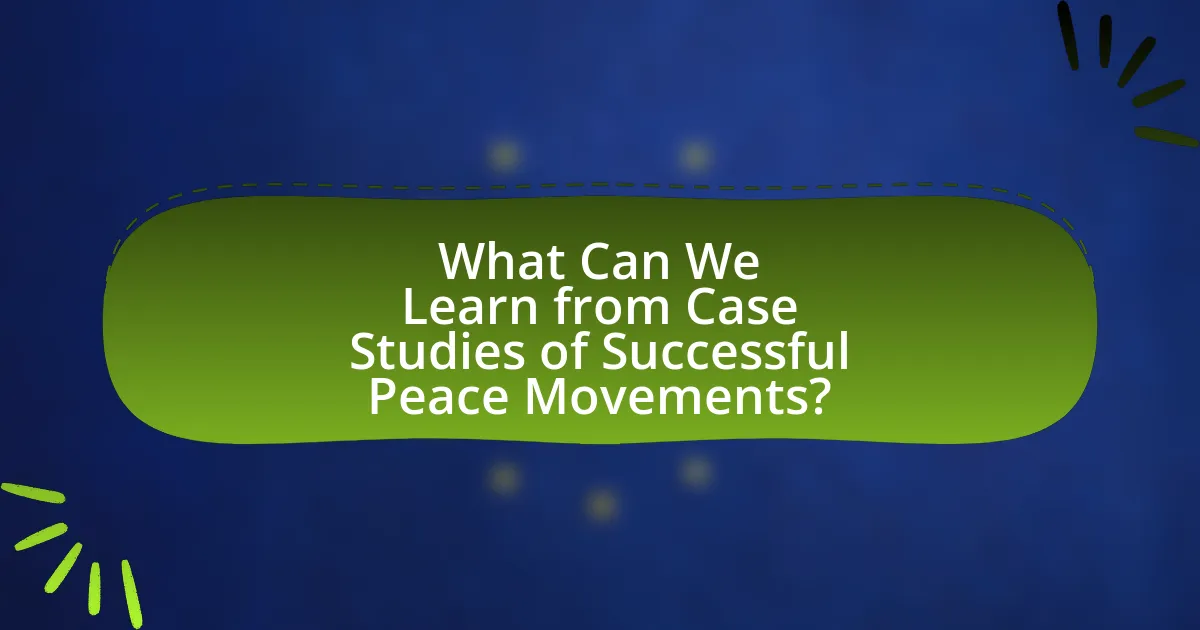
What Can We Learn from Case Studies of Successful Peace Movements?
Case studies of successful peace movements reveal that strategic nonviolent action, community mobilization, and clear communication are essential for achieving lasting change. For instance, the Civil Rights Movement in the United States effectively utilized nonviolent protests, such as the Montgomery Bus Boycott, which led to significant legislative changes like the Civil Rights Act of 1964. Additionally, the anti-apartheid movement in South Africa demonstrated the power of international solidarity and grassroots organizing, culminating in the end of apartheid and the establishment of a democratic government in 1994. These examples illustrate that successful peace movements often rely on a combination of strategic planning, widespread participation, and the ability to articulate a clear vision for justice and equality.
What are some notable case studies of successful peace movements?
Notable case studies of successful peace movements include the Indian independence movement led by Mahatma Gandhi, which utilized nonviolent resistance to achieve independence from British rule in 1947, demonstrating the power of civil disobedience. Another significant example is the American civil rights movement, particularly the 1963 March on Washington, where Martin Luther King Jr. delivered his “I Have a Dream” speech, leading to the Civil Rights Act of 1964. Additionally, the anti-apartheid movement in South Africa, spearheaded by figures like Nelson Mandela, successfully dismantled institutionalized racial segregation, culminating in the first multiracial elections in 1994. Each of these movements effectively mobilized mass support and employed strategic nonviolent tactics to achieve their goals, showcasing the impact of organized, peaceful resistance.
What lessons can be drawn from the Civil Rights Movement in the United States?
The Civil Rights Movement in the United States teaches the importance of nonviolent protest, grassroots organizing, and coalition-building. Nonviolent strategies, exemplified by figures like Martin Luther King Jr., effectively mobilized public support and drew national attention to racial injustices, leading to significant legislative changes such as the Civil Rights Act of 1964. Grassroots organizing empowered local communities to take action, demonstrating that collective efforts can challenge systemic oppression. Additionally, the movement’s success relied on building coalitions across diverse groups, highlighting the effectiveness of unity in pursuing social justice. These lessons underscore the potential for organized, peaceful resistance to effect meaningful change in society.
How did the anti-apartheid movement in South Africa achieve its goals?
The anti-apartheid movement in South Africa achieved its goals through a combination of grassroots activism, international pressure, and strategic negotiations. Grassroots activism involved mass protests, strikes, and civil disobedience led by organizations such as the African National Congress (ANC) and the Pan Africanist Congress (PAC), which mobilized widespread support against apartheid policies. International pressure was exerted through economic sanctions and cultural boycotts, notably by countries and organizations that condemned apartheid, which weakened the South African economy and isolated the regime diplomatically. Strategic negotiations culminated in the unbanning of the ANC in 1990 and the subsequent negotiations that led to the first multiracial elections in 1994, resulting in Nelson Mandela’s election as president. These combined efforts effectively dismantled the apartheid system and established a democratic government in South Africa.
What strategies were particularly effective in these case studies?
Effective strategies in successful peace movements include nonviolent resistance, grassroots mobilization, and coalition-building. Nonviolent resistance, exemplified by movements like Gandhi’s Salt March, demonstrated that peaceful protests could effectively challenge oppressive regimes. Grassroots mobilization, as seen in the Civil Rights Movement, empowered local communities to advocate for change, leading to significant legislative reforms. Coalition-building, illustrated by the anti-apartheid movement in South Africa, united diverse groups to strengthen their collective impact, ultimately contributing to the dismantling of apartheid. These strategies have proven effective in achieving social and political change through peaceful means.
How did communication strategies impact the success of these movements?
Communication strategies significantly influenced the success of peace movements by facilitating widespread awareness and mobilization. Effective use of social media platforms, for instance, allowed movements like Black Lives Matter to rapidly disseminate information, organize protests, and engage supporters globally, resulting in increased visibility and pressure on policymakers. Historical examples, such as the Civil Rights Movement, demonstrate that strategic communication through speeches, pamphlets, and media coverage galvanized public support and drew national attention to injustices, ultimately leading to legislative changes like the Civil Rights Act of 1964. These strategies not only informed participants but also shaped public perception, making communication a critical component in the effectiveness of peace movements.
What role did international support play in these peace movements?
International support significantly bolstered peace movements by providing resources, legitimacy, and global attention. For instance, during the anti-apartheid movement in South Africa, international sanctions and divestment campaigns pressured the South African government, demonstrating how external support can influence domestic policies. Additionally, organizations like Amnesty International and the United Nations amplified the voices of peace activists, enhancing their credibility and mobilizing global public opinion. This combination of economic pressure and moral support often catalyzed change, as seen in the successful transition to democracy in South Africa in the early 1990s.
What practical insights can be applied to current peace initiatives?
Practical insights that can be applied to current peace initiatives include the importance of grassroots mobilization, inclusive dialogue, and leveraging technology for communication. Grassroots mobilization has proven effective in various successful peace movements, such as the Civil Rights Movement in the United States, where community engagement led to significant legislative changes. Inclusive dialogue, as seen in the South African transition from apartheid, emphasizes the need for all stakeholders, including marginalized groups, to participate in peace processes. Additionally, leveraging technology, demonstrated by movements like the Arab Spring, can enhance communication and coordination among activists, facilitating rapid organization and information dissemination. These strategies underscore the necessity of community involvement, broad representation, and modern communication tools in fostering effective peace initiatives.
What best practices can be derived from successful peace movements?
Successful peace movements demonstrate several best practices, including grassroots mobilization, nonviolent resistance, and coalition-building. Grassroots mobilization engages communities at the local level, fostering a sense of ownership and commitment, as seen in the Civil Rights Movement in the United States, which effectively utilized local leaders to inspire action. Nonviolent resistance, exemplified by Mahatma Gandhi’s Salt March, proves to be a powerful strategy that draws public attention and sympathy while minimizing backlash. Coalition-building among diverse groups enhances the movement’s reach and effectiveness, as demonstrated by the anti-apartheid movement in South Africa, which united various organizations and demographics to challenge systemic injustice. These practices collectively contribute to the sustainability and impact of peace movements.
How can current movements adapt strategies from historical case studies?
Current movements can adapt strategies from historical case studies by analyzing successful tactics, understanding the context in which they were implemented, and tailoring them to contemporary issues. For instance, the Civil Rights Movement in the United States utilized nonviolent protest and grassroots organizing, which can inform current movements by emphasizing the importance of community engagement and peaceful demonstration. Historical evidence shows that the Montgomery Bus Boycott effectively mobilized local communities and garnered national attention, illustrating how strategic planning and coalition-building can lead to significant social change. By studying these case studies, current movements can identify effective communication methods, leverage media coverage, and foster solidarity among diverse groups to enhance their impact.
